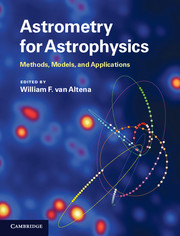Book contents
- Frontmatter
- Contents
- List of contributors
- List of acronyms
- Preface
- Part I Astrometry in the twenty-first century
- Part II Foundations of astrometry and celestial mechanics
- 4 Vectors in astrometry: an introduction
- 5 Relativistic foundations of astrometry and celestial mechanics
- 6 Celestial mechanics of the N-body problem
- 7 Celestial coordinate systems and positions
- 8 Fundamental algorithms for celestial coordinate systems and positions
- Part III Observing through the atmosphere
- Part IV From detected photons to the celestial sphere
- Part V Applications of astrometry to topics in astrophysics
- Index
- References
4 - Vectors in astrometry: an introduction
from Part II - Foundations of astrometry and celestial mechanics
Published online by Cambridge University Press: 05 December 2012
- Frontmatter
- Contents
- List of contributors
- List of acronyms
- Preface
- Part I Astrometry in the twenty-first century
- Part II Foundations of astrometry and celestial mechanics
- 4 Vectors in astrometry: an introduction
- 5 Relativistic foundations of astrometry and celestial mechanics
- 6 Celestial mechanics of the N-body problem
- 7 Celestial coordinate systems and positions
- 8 Fundamental algorithms for celestial coordinate systems and positions
- Part III Observing through the atmosphere
- Part IV From detected photons to the celestial sphere
- Part V Applications of astrometry to topics in astrophysics
- Index
- References
Summary
Introduction
In astrometry, vectors are extensively used to describe the geometrical relationships among celestial bodies, for example between the observer and the observed object. Practical calculations using computer software are today mainly carried out with the help of vector and matrix algebra, rather than the trigonometry formulae typically found in older textbooks. It turns out that this often provides a better insight into the problem, and hence reduces the risk of errors in the derived algorithms, in addition to being advantageous in terms of computational speed and accuracy.
This chapter provides a brief introduction to the use of vectors and matrices in astrometry. It broadly uses the notational conventions from C. A. Murray's Vectorial Astrometry (1983), which seem to provide a particularly clear and consistent framework for theoretical work as well as practical calculations. By way of illustration, some useful transformations are explained in detail, while references to the general literature are provided for other applications. Only vectors in three-dimensional Euclidean space are considered.
What are vectors?
In this section we define classical vectors, unit vectors, matrices and present some important formulae for manipulating them.
Vectors and matrices
Classically, a vector is defined as a physical entity having both magnitude (length) and direction, as opposed to a scalar that only has magnitude. Vectors can be visualized as arrows that exist in space quite independently of any coordinate system. The usual vector operations – addition, subtraction, multiplication by a scalar, scalar (dot) product, and vector (cross) product – have simple geometrical interpretations that are independent of the coordinate system.
- Type
- Chapter
- Information
- Astrometry for AstrophysicsMethods, Models, and Applications, pp. 39 - 46Publisher: Cambridge University PressPrint publication year: 2012



